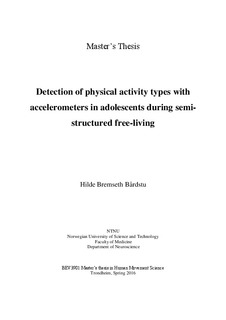| dc.description.abstract | Background Few algorithms are available for detection and classification of physical activity (PA) types in adolescents, and existing algorithms are only validated in controlled laboratory settings. The performance of such algorithms outside of the laboratory in adolescents remains unexplored. Several algorithms have been developed and validated for adults but it is uncertain if these algorithms are valid for detection and classification of PA in adolescents.
Aim The aim of this study was to evaluate the validity of an algorithm developed for detection of PA in adolescents (NTNUADOL). A comparison was made against the performance of an algorithm developed for detection of PA in adults (NTNUADUL). The evaluation of the validity was based on the algorithms performance in detecting PA types in adolescent during semi-structured free-living.
Methods Twelve adolescents (6 boys, 6 girls, mean age 14.7 years, range 13-16 years) were equipped with two accelerometers (Axivity AX3) and a chest-mounted camera. A semi-structured free-living session for detection of PA types was carried out. Video recordings were used as validation criterion, and PA types were defined and used as guidelines for annotation of the video-recordings. Two algorithms, NTNUADOL and NTNUADUL, were developed and used for analysis. To test the performance of the NTNU-algorithms a reference was made against an existing algorithm developed for adults (Acti4) in a separate analysis. Walking, standing, sitting, lying down, shuffling, walking stairs, running and other vigorous PA was analyzed. Overall accuracy was calculated for each algorithm. Sensitivity, specificity and accuracy were calculated for each PA type. Confusion matrices were included to show the distribution of correctly and incorrectly classified instances.
Results Overall accuracy was 87% for NTNUADOL and 85% for NTNUADUL. Both algorithms could detect walking, standing, sitting, lying down and running with sensitivity above 80%. Specificity and accuracy was high (>87%) for both algorithms. The NTNUADOL showed highest sensitivity for detection of walking, standing, sitting, lying down, running, walking stairs up and other vigorous PA, while NTNUADUL showed higher sensitivity for shuffling and walking stairs down. Most misclassifications were due to insufficient discrimination between shuffling, walking and standing, and between walking stairs and horizontal walking
Conclusion Both algorithms were able to detect walking, sitting, standing, lying down and running with acceptable to high performance. There were no major differences between the algorithms. The most evident differences were found for detection of other vigorous PA with the NTNUADOL being superior and shuffling with the NTNUADUL being superior. | nb_NO |
